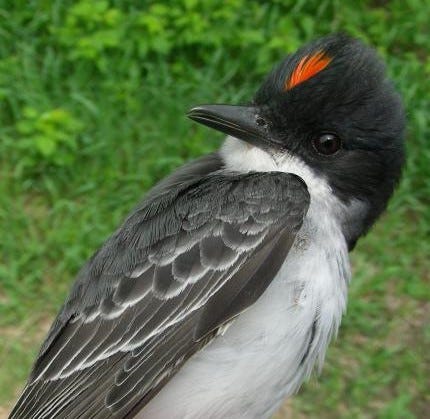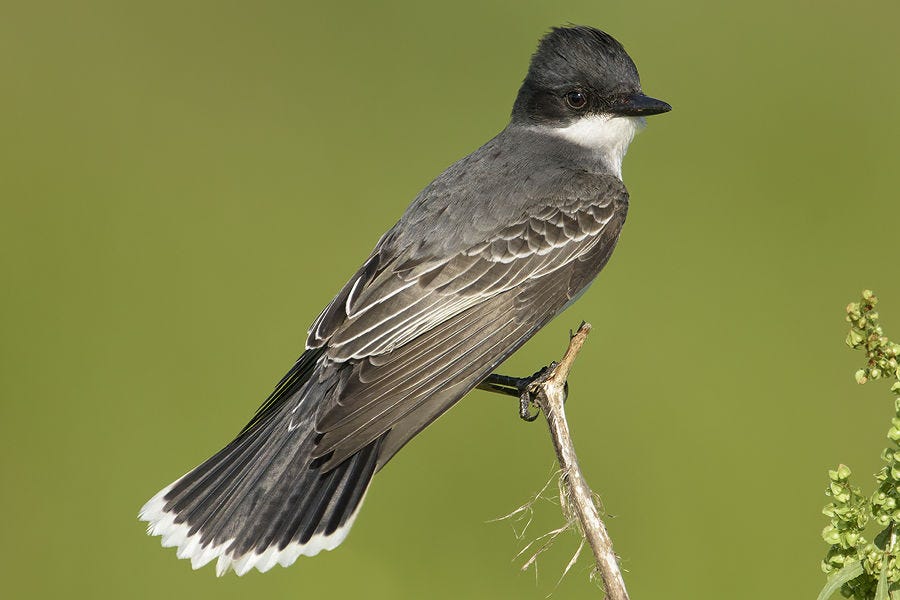
King of kings
A soft thunk had me racing into my living room last June, heart in my throat. A slender, feathered body lay motionless on my deck. Feeling utterly dismayed, I rushed outside to investigate. I live in a house dominated by windows, which poses a significant threat to birds. Applying window decals that disrupt the natural scenes reflected in the windows has been remarkably successful at keeping my window strikes to a minimum. But they do happen. And I have had two deaths—that I know of—in the last 7 years. Regrettably, I am not alone. Every year, more than one billion birds are killed by striking windows in the US.
My dismay only increased when I saw the elegant black and white bird that had collided with my window only a foot or so above the deck—a spot where I’d thought decals were unnecessary. An Eastern Kingbird—a beautiful flycatcher that had only recently returned to my neighborhood after its long migratory journey. Though these kingbirds frequent open habitats, including fields with scattered trees and shrubs, waterways, and forest edges, I hadn’t had them around my house until recently. But for a week or so, I’d been enjoying a pair that was visiting my bird bath each evening and foraging for insects around my yard. And now, as the sun approached the western horizon, one of them had struck my window. But as I reached down to pick up the kingbird, I realized to my relief that it was still alive. A window strike, not a fatality. Yet.
The kingbird struggled briefly in my hands, and then seemed to fade, its eyes closing. Not wanting to cause it more stress by holding it, I gently placed it on a branch in a sagebrush bush close to my house. I could keep an eye on it from a window and make sure it stayed safe from predators while it tried to recover. It was strong enough to hold on to a branch, but too disoriented to flee from me. An hour later it was still there, and I worried that it would be killed overnight. Setting up some perches in a soft-sided dog crate, I again caught the stunned bird and placed it in the crate, leaving it in the dark safety of my garage.
I had heard that birds that struck windows and flew off rarely survived, so I wasn’t hopeful about my poor kingbird’s chances. And I was heartsick that it had journeyed successfully all the way from the Amazon only to have its life cut short by someone who wanted nothing more than to help birds.
Eastern Kingbirds belong to the largest family of birds in the world—the tyrant flycatchers—which number more than 400 species in the western hemisphere. The family’s name originated in the 1730s when a visiting British naturalist described the Eastern Kingbird as a tyrant because of the bird’s ferocious defense of its nesting territory. Eastern Kingbirds routinely attack large birds like Red-tailed Hawks, American Crows, Great Blue Herons, and any other bird that passes through their territory, including fellow kingbirds. The bird’s legendary ferocity is captured in its scientific name Tyrannus tyrannus, which translates to “tyrant, despot, or king.”
Despite their common name, Eastern Kingbirds are found as far west as the Pacific Ocean in Washington state and British Columbia. Although they’re commonly seen pursuing flying insects from stationary perches, the birds undergo a remarkable behavioral and dietary shift in the non-breeding season. Before and during their migration to South America, the birds eat more and more berries to help fuel their lengthy journey. And on their wintering grounds in western Amazonia, formerly pugnacious Eastern Kingbirds travel in harmonious flocks, foraging mostly on fruit in the forest canopy along the borders of rivers and lakes.
Imagining my kingbird perched on the edge of a humid tropical forest ringing with the insistent hum of cicadas, as monkeys clambered through the treetops nearby and parrots winged overhead, only increased my dread at what I would find when I returned to my garage the next morning. Peeking into the crate, I was startled by a loud screech and panicked flapping. Feisty and aggressive, the kingbird raised its head feathers, flashing its red crown, as it alarm-called and threw itself against the back wall. I moved out of view, smiling in relief and astonishment, then carefully carried the crate outside. Standing behind it, I leaned over and unzipped the front door. Rocketing out of the carrier, the kingbird flew with strong, sure wingbeats to a nearby clump of ponderosa pines. It gave no hint of the previous day’s trauma, moving quickly out of view.
In the coming days, I relished seeing my kingbird pair, swooping from perches to catch insects and visiting my bird bath during the quiet that precedes evening. And my ongoing relief at their story’s happy outcome only intensified my commitment to providing a welcoming and safe space for my neighborhood birds. After all, they deserved a habitat fit for kings.

Take a small step to help birds
Birds are in crisis and need our help more than ever. According to the US Fish and Wildlife Service, over 96 million people in North America watch birds. If each of us does something (anything!) to help them, we may be able to reverse declining bird numbers.
Eastern Kingbirds are often found near water and will readily incorporate bits of trash when lining their nests. One female kingbird was found entangled in fishing line that she’d woven into her nest. If you fish this summer, please do your utmost to retrieve your discarded fishing line along with any other fishing line or trash you find during your aquatic explorations.
Applying window decals can drastically reduce the likelihood of birds’ striking windows. The more decals you apply, the better, but any decals at all are far better than none.
Because Eastern Kingbirds nest in open areas, and often forage near roads, they are frequently killed by vehicles. (Between 89 million and 340 million birds die each year in the US from vehicle strikes.) The best way we can help is to keep an eye out for perched or flying birds while driving, and slow down if we see birds close to the road.
Everything we do to help our beleaguered native insects helps insectivores like kingbirds and the many birds that feed insects to their young. Our native insects have not evolved to cope with the toxins and defenses of non-native/alien ornamental plants, so much of suburbia has become a food desert for our insects. Planting a few native shrubs or perennials is one of the best ways to help native insects, which in turn provide food for our birds.
You can also provide a little more habitat for insects by letting portions of your lawn go wild. These wilder areas provide shelter and food for insects and other wildlife.
Until next time …
P.S. To learn more about the biggest human-caused threat to birds—outdoor cats, which kill around 2.4 billion birds a year, check out my new book Feather Trails—A Journey of Discovery Among Endangered Birds and learn how cat lovers (like me!) can help.





Awesome article! They're amazing birds and I love how regal and elegant they look. They are FEISTY! Banding them years ago was always a treat. They were so indignant at such rude treatment and also very poised and royal. Amazing birds. I love that they eat berries all winter, who knew?
I'm so glad this story ended well! As always, beautiful and engaging writing!